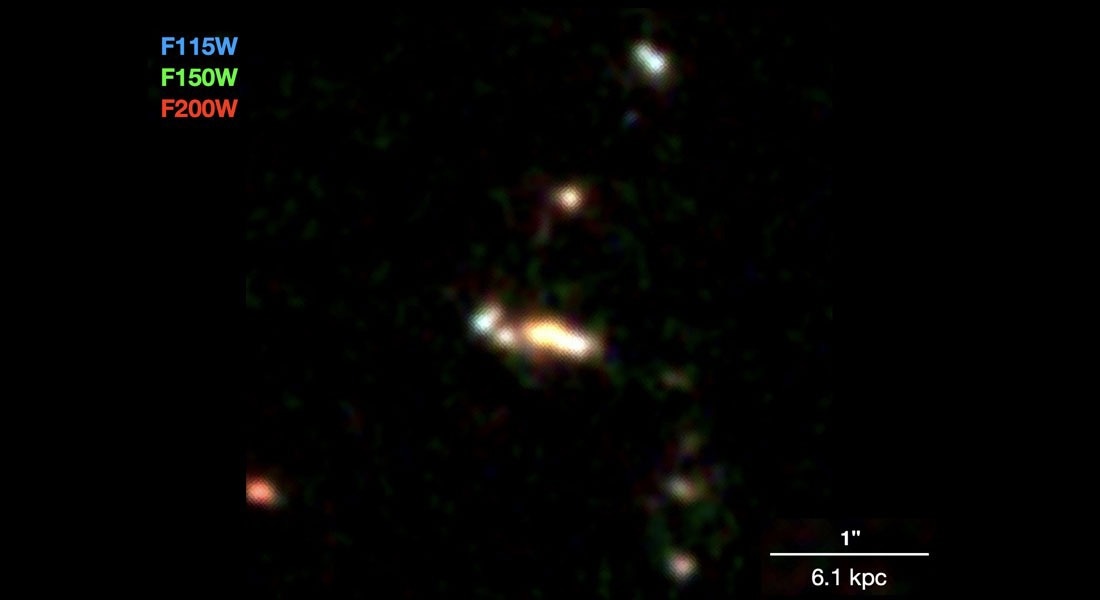New observations contributing to galaxy formation theories have been presented by astronomers from the Cosmic Dawn Center using the James Webb Space Telescope.

A group of small galaxies, seen almost 13 billion years back in time, likely in the process of forming a massive galaxy. The colors are composed of three different infrared colors. The white, horizontal bar shows the scale of approximately 20,000 lightyears. Image Credit: Shuowen Jin et al. (2023).
The researchers have observed a group of small galaxies in the process of forming a larger galaxy. They have assumed it will probably be the progenitor of a huge, Milky Way-like galaxy. The breakthrough corroborates the current understanding of how galaxies develop.
As per current knowledge, galaxies develop hierarchically, consisting of small systems developed initially in the very early Universe, and then later fusing to build bigger systems. This is the main theory backed by computer simulations and verified by observations of galaxies at numerous epochs in the history of the Universe.
To consider the assembly of the very first systems, one has to look as far back in time, and hence as distant as possible. However, the evidence of these systems is both very small and faint, and their detection needs sophisticated technologies.
In a new study, the early progenitor of what today will probably have evolved to be a huge galaxy was detected. This smaller galaxy group, called CGG-z5, was discovered via the observational program known as “CEERS” with the James Webb Space Telescope and was observed when the Universe was just 1.1 billion years old, just 8% of its current age.
CGG-z5 was discovered with the help of the code GalCluster, which was made by Nikolaj Sillassen, an MSc student at the Cosmic Dawn Center (DAWN).
I developed the software during my studies to detect this kind of structures, and now we applied it to data from the CEERS program. It’s great to see how useful my code is becoming.
Nikolaj Sillassen, MSc Student, Cosmic Dawn Center
Sillassen had already discovered a similar but closer group while testing the software.
Impossible Without James Webb
The brightest members of the galaxy group were found previously with the Hubble Space Telescope. However, the CEERS program discovered new and smaller members.
“The other members of the group are both small and faint. Without the sensitivity and the spatial resolution of James Webb, we simply wouldn't be able to detect them,” explained Shuowen Jin, Marie Curie Fellow at the Cosmic Dawn Center (DAWN) and lead author of the current study.
What will be the exact “future” of the galaxy group named CGG-z5 is, of course, unknown. Instead of developing a single galaxy, it could be that the group progressed into a huge cluster of galaxies. Another chance is that the members are in reality not as tightly packed as they appear to be.
Help From Computer Simulations
For such scenarios to be differentiated, highly accurate observations using spectroscopic analysis are required.
In order to better understand the nature and evolution of CGG-z5, we searched for similar structures in large-scale, hydrodynamical simulations.
Aswin Vijiayan, Postdoctoral Fellow, Cosmic Dawn Center
Vijiayan added, “We found 14 structures that match closely the physical properties of our observed group CGG-z5, and then traced the evolution of these structures through time in the simulations, from the early Universe to the present epoch.”
Vijiayan performed the simulation analysis in the study.
Even though the exact unfolding of the evolution of the 14 structures seems to be diverse, they all shared the same fate: approximately 0.5 to 1 billion years later, they combined to develop an individual galaxy which, by the time the Universe was half its current age, had a mass equivalent to the Milky Way.
Given the predictions of the simulations, it is therefore tempting to speculate that the CGG-z5 system will also follow a similar evolutionary path, and that we captured the process of small galaxies assembling into a single massive galaxy.
Shuowen Jin, Study Lead Author and Marie Curie Fellow, Cosmic Dawn Center
“Interestingly, the number of these early groups like CGG-z5 in a given volume of space is similar to the number of massive galaxies at later cosmic times. This makes merging groups appealing as the main progenitors of massive galaxies at later epochs,” concluded Georgios Magdis, Associate Professor at DAWN and partaker in the study.
Journal Reference
Jin, S., et al. (2022) Massive galaxy formation caught in action at z~5 with JWST. Astronomy & Astrophysics. doi.org/10.1051/0004-6361/202245724.